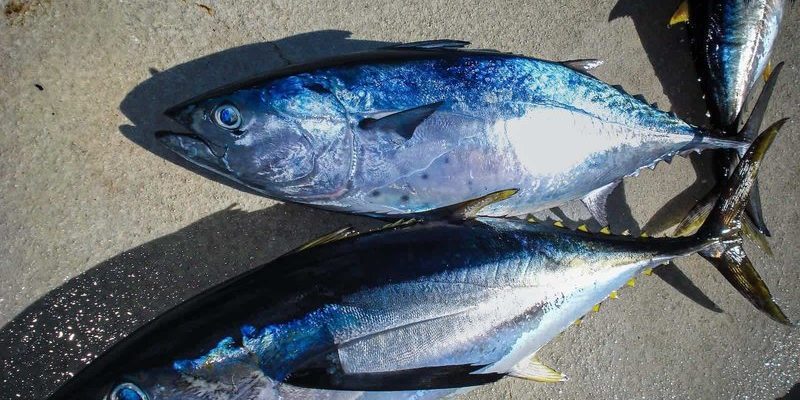![Yellowfin Tuna Vs. [Similar Species] - Key Differences](https://gudri.com/wp-content/uploads/2025/06/Yellowfin_Tuna_Vs___Similar_Species______Key_Differences_image_0.jpg)
But how does the yellowfin tuna stack up against its relatives, like the bluefin or albacore tuna? Each species has its own unique traits, and understanding these differences can help you make smarter choices when it comes to cooking, sustainability, or even just impressing friends with your seafood knowledge! So grab a cup of coffee, and let’s dive into the fascinating world of tuna species.
What is Yellowfin Tuna?
Yellowfin tuna, also known as *Thunnus albacares*, is one of the most sought-after types of tuna out there. What makes it special? First off, it’s known for its striking yellow fins and streamlined body. This fish can grow up to 400 pounds and is famous for its delicious, meaty flavor. Honestly, the texture is smooth and firm, making it perfect for grilling, searing, or even enjoying raw as sashimi.
Yellowfin tuna is typically found in warm ocean waters, thriving in both the Atlantic and Pacific Oceans. Besides its taste, this species is loved for its high protein content and omega-3 fatty acids, which are great for heart health. So, if you’re looking for a tasty and nutritious option for dinner, yellowfin is definitely a strong contender.
Bluefin Tuna: The Heavyweight Champion
Now, let’s see how yellowfin compares to its big brother, the bluefin tuna. The bluefin tuna, which includes varieties like the Atlantic, Pacific, and Southern bluefin, can weigh over 1,000 pounds. Yes, you heard that right! That’s a serious heavyweight in the fish world.
What really sets bluefin apart is its high fat content, which gives it a rich, buttery taste. If you’ve ever had high-end sushi, chances are you’ve had bluefin tuna. However, this species is also facing serious sustainability issues due to overfishing. Many restaurants are now opting for yellowfin as a more sustainable choice. You might be wondering: is it worth it? Well, if you love a rich, complex flavor, bluefin is definitely the way to go—just keep sustainability in your mind.
Albacore Tuna: The “Chicken of the Sea”
Another tuna that often comes up in conversation is albacore, sometimes affectionately called the “chicken of the sea.” This name reflects its mild, delicate flavor, which many find more approachable than the stronger tastes of yellowfin and bluefin. Albacore is smaller, typically weighing up to 50 pounds, and is most commonly found in temperate waters.
When it comes to cooking, albacore is fantastic for grilling, but it’s also the tuna variety most often canned. That’s right; if you’re enjoying a classic tuna salad, it’s probably made with albacore! It’s a great option for those who want a lighter, less intense tuna dish. Overall, if you’re not a big fan of fishy flavors, albacore might be your best bet.
Texture and Taste Differences
The textures of yellowfin, bluefin, and albacore vary quite a bit, affecting how they’re used in cooking. Yellowfin has a firm texture, which holds up well for grilling and searing. Its flavor is mildly sweet and savory, making it versatile for many dishes.
Bluefin, on the other hand, is known for its rich, fatty texture, which melts in the mouth. This makes it ideal for sushi and sashimi, but it may not be your best choice if you’re grilling. Albacore offers a softer, flaky texture that’s perfect for salads and lighter dishes. Each type of tuna has a unique flavor and mouthfeel, so don’t hesitate to experiment and find what you love!
Health Benefits of Yellowfin Tuna
Now, let’s talk health! Yellowfin tuna is not just delicious; it’s a powerhouse of nutrients. It’s an excellent source of lean protein, which is essential for muscle growth and repair. Plus, it’s rich in omega-3 fatty acids, which are known for their heart-healthy benefits.
Eating yellowfin also provides vitamins such as B12 and selenium, which help with energy metabolism and immune function. If you’re looking for a nutritious way to boost your diet, adding yellowfin tuna to your meals could seriously up your health game. Just remember to enjoy it in moderation, as with any fish, to avoid potential mercury exposure.
Environmental Impact and Sustainability
When choosing between yellowfin and other tuna species, sustainability is a crucial factor. Yellowfin tuna populations are currently considered relatively stable compared to bluefin, which faces significant overfishing challenges. Many organizations advocate for responsible fishing methods, and you might even notice labels like “pole-and-line caught,” ensuring the fish is harvested sustainably.
The goal is to enjoy these delicious fish while protecting their populations for future generations. If you can, look for seafood from certified sustainable sources. Your choices at the dinner table can have a big impact on ocean health!
Final Thoughts: Choosing Your Tuna
In the end, whether you choose yellowfin, bluefin, or albacore tuna comes down to your taste preferences and values. Yellowfin is a versatile, sustainable option that appeals to many seafood lovers. Bluefin offers a rich flavor, but you should consider its environmental impact. Albacore is your gentle choice for those new to eating fish or those who prefer a milder taste.
So, next time you’re shopping for tuna, remember the differences we discussed. Each species has its own unique traits, and understanding them can help you make better, more informed choices. Enjoy exploring the world of tuna—it’s a delicious journey!

